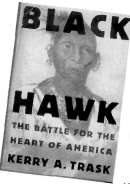 |
Home | Search | Browse | About IPO | Staff | Links |
 |
Home | Search | Browse | About IPO | Staff | Links |
  Terror on the prairie Black Hawk: The Battle for the Heart of America Black Hawk was neither a young warrior (he was 65) nor a tribal chief when, in the spring of 1832, he led 1,500 Sauk and Fox Indians—two-thirds of them women and children— across the Mississippi and back to Saukenauk, their ancestral home near Rock Island. It had been a hard winter in Iowa and the tribe, known as the "English Band" for its misalliances in the War of 1812, was starving. They could see their abandoned crops growing in Illinois, on land that had been stolen from them. Their move was more an act of survival than of aggression; nevertheless, it ignited Indian hatred across America and led to a bloodbath beside the Mississippi River. But the slaughter of the Sauk and Fox by U.S. soldiers and frontier militiamen at the battle of Bad Axe (Wisconsin) in August of 1832, never made it into most history textbooks. Of the members of Black Hawk's band who crossed the Mississippi River into Illinois that summer, only 39 were taken captive after the battle. "We killed everything that didn't surrender,'' one U.S. soldier later admitted. The Black Hawk "war," on the other hand, made national headlines. American heroes and future presidents were made, pensions and land grants were doled out, and statues were erected in honor of the fallen soldiers. But it was anything but a war. Abraham Lincoln, who served in the Illinois militia during the conflict—first as a private and later as a captain—joked that he didn't see much of the enemy, but "had a good many bloody experiences with the mosquitoes." Honest Abe wasn't at Bad Axe, which perhaps explains why we've had to wait this long for an honest account. In Black Hawk: The Battle for the Heart of America, Kerry Trask serves up perhaps the best one-volume history of the brief conflict, a blessing for those who haven't time to sift through the Illinois State Historical Society's dense, multi-volume record of the war. He wastes little time justifying the violent actions of settlers or warriors; atrocities were committed on both sides, and vengeance—not Christian charity—was ever the law of the frontier. What he does—and does well—is tell a tragic story of clashing cultures on a collision course with destiny. While New Englanders romanticized the "noble savage" and mourned his absence in the east, Indian hating in the west had become part of the cultural identity. Though some frontiersmen (most noticeably the French) worked hard to develop friendships, alliances, and trade agreements with the natives, the Americans had other priorities. Americans espoused human rights and personal freedom in their Constitution, Trask observes, but they were driven by "powerful imperialistic drives and ambitions and a seemingly insatiable appetite for new territory, usually acquired by armed aggression with little regard for the rights and interests of the continent's indigenous people.... [T]he more Americans emphasized the importance of their own rights and goals, the less they regarded or respected the rights or even the lives of groups of people they considered to be 'others.'" Trask explains the intricacies and deceptions of the treaties of 1804 and 1816, which with two pen strokes stripped away forever the Sauk and Fox's birthright and burial ground of in the Rock River valley. One of the many ironies of the war is that, when the Sauk tribeswomen realized how they had been swindled, they sent a delegation to Jefferson Barracks at St. Louis to protest the treaties on the grounds that the land rightfully belonged to the women who farmed it, not to the men, who only hunted on it. The Americans, of course, refused to hear this argument; the treaties had been forged and signed by men, and women in "civilized" culture didn't own land. While some tribes accepted and tried to live with the Americans on the frontier, Black Hawk, an "unyielding traditionalist," resisted. Trask writes: [H]e honored the old customs and ways, never wearing white people's clothing or tasting their alcohol in any form....[A] mid the great confusion and vicissitudes unleashed by the white people, he held steady and was seen to be the very personification of the tribe's authentic collective identity. He was, thought his followers, what a Sauk man ought to be... all they had once been and hoped to become again." Not surprisingly, the Black Hawk war is the only conflict in American history named for an individual. Black Hawk personified native life and custom, fought with the British in the late war with America, and was contemptuous of military authority. He was the perfect enemy for a nation looking for a fight. The greater Sauk and Fox nation, led by Keokuk, had accepted peace and moved onto their reservation in Iowa. Trask is an engaging writer who presents a broader portrait of the conflict than we've seen previously. And he introduces readers to a cast of characters representing the best—and worst—of humanity. He has given Illinoisans a great gift with this book. As he so rightly observes, "By looking into this brief but horrific conflict, we may begin to better understand ourselves by discovering in the events of that angry, not so long ago, rain-soaked summer how we came to be who we think we are." —William Furry Illinois Heritage 25 |
|
|